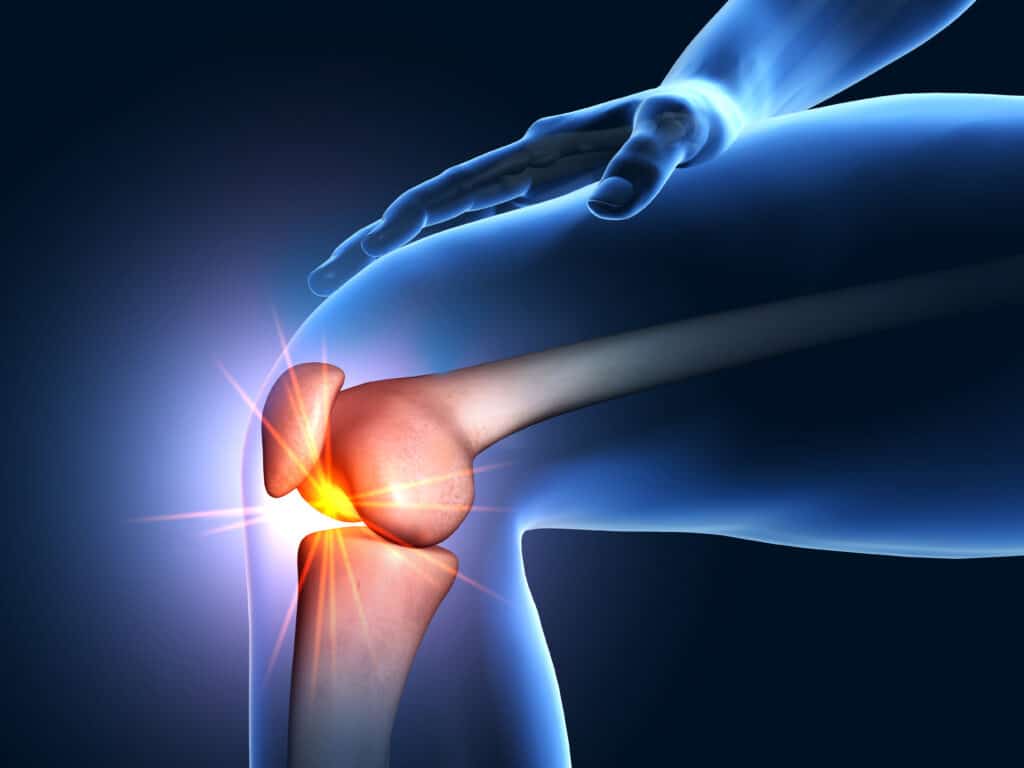Finding Relief from Knee Pain & Achy Knees

Reviewed by Dr. Ronald Spiaggia
Do your knees hurt? Knee pain affects about 25% of adults in the U.S., so you’re not alone if you suffer from it. It not only limits your function and mobility but also reduces your quality of life. In fact, knee pain is responsible for nearly a third of all doctor visits for muscle and bone pain.
What Causes Knee Pain?
Your knees not only bear a lot of your weight, but they also take the daily wear and tear. Due to this, there can be many causes for knee pain. The following are the four common causes of knee pain:
- Arthritis – As people get older, the cartilage in their knees can wear out, just like an old door hinge can get rusty. Arthritis is a condition that affects over 32.5 million adults in the U.S., specifically a type called osteoarthritis. It can make your knees feel stiff and sore, like trying to open a door that doesn’t want to move.
- Injuries – Think about all the activities you do, these sometimes may lead to a fall or getting hit. Resulting on a sprain (stretch or tear a ligament, which connects bone to bone), strain (hurt a muscle), or even tear something. It’s like when you break a toy – it doesn’t work right until someone fixes it.
- Overuse – If you do the same motion over and over, like squatting down or climbing a lot of stairs, your knee can get irritated. Imagine bending a paperclip back and forth many times – it eventually breaks. Just think about the numerous repetitive motions you do everyday – doing all these activities can hurt your knees.
- Illness – Sometimes, what’s happening inside your body can make your knees hurt. Diseases like bursitis, this is caused when the “bursa,” a special pillow-like thing in your body, gets irritated and swollen. It can make the area hurt and feel a bit swollen. Other illnesses can be iliotibial band syndrome or Osgood-Schlatter disease.
Understanding the Different Pains of Knee Pain
Knee pain isn’t just one-size-fits-all; it can feel different depending on the underlying cause. Different types of pains can mean a different thing. Let’s take a closer look:
- Sharp Pain: Sharp knee pain feels sudden and intense. It signals that something just happened inside the knee. This kind of pain should get checked out, especially if it doesn’t go away quickly. It could mean something inside the knee, like a ligament or the meniscus (knee cartilage), sustained significant damage.
- Dull, Aching Pain, Persistent Throb: This kind of pain does not stem from sudden injuries. Rather, it feels more like a constant reminder that something is not right in the knee joint. If knees ache and feel stiff, especially when waking up or after sitting for a long time, arthritis may be the culprit.
- Pain with Movement: Ever notice your knee complains when moving around, bending, or squatting? Certain activities can put a lot of pressure on knees. This kind of discomfort can stem from excessive use of the joint or a wound that hasn’t completely healed.
- Swelling and Tenderness: Sometimes, knees might become swollen and tender to the touch. This response can be caused by injuries or diseases like rheumatoid arthritis. Picture your knee as a water balloon filled too full — it grows puffy and might hurt when poked. Swelling means your body is trying to heal, but too much swelling needs medical help to reduce inflammation.
- Warmth and Redness: If a knee feels unusually warm or appears visibly red, that also signals trouble inside the joint. It resembles the body’s fever response when fighting an infection. Inflammation causes warmth and redness as the body sends blood and immune cells to heal the area.
- Cracking or Popping Sounds: Do your knees ever sound like when you are eating cereal? Crackling, popping, or snapping sounds don’t always mean injury, but if they come with pain or swelling, pay attention. The rough textures grinding inside the joint may produce these sounds.
To learn more about knee pain and treatment options, check out our webinar Ask the Doc: Knee Pain with Dr Mejia.
Dos and Don’ts for Knee Pain Relief
When managing knee pain, some basic knowledge goes a long way towards relieving your knee pain. Here’s a simple list of recommended and not recommended actions to keep knees as pain-free as possible:
Do
- Gentle Exercise: Keep moving, but take it easy. If you have knee pain, walking can actually be beneficial as long as it’s not causing more pain.
- Stretch: Think of leg muscles like rubber bands. If they become too tight, they do not work well. Stretching maintains flexibility.
- Healthy Weight: Your knees absorb shock like the struts on a vehicle; heavier weight overloads them. Keeping a healthy weight ensures knees do not endure excess strain.
Don’t
- Overdo It: Avoid intensive jumping or running if knees hurt. Listen to your body.
- Skip the Doc: Persistent knee pain warrants medical attention for a professional assessment. Call us for a consultation at 908-754-1960 or book an appointment with us.
- Ignore It: Pain serves like an alarm system. Don’t ignore it. Determine the cause.
Ways to Find Relief from Knee Pain
Knee Pain Home Remedies
- Ice Packs: Fifteen minutes of ice treatment can work wonders.
- OTC Medications: Over-the-counter meds can take the edge off the pain – think of them like a mute button.
- Knee Brace: Wearing a brace can make it feel secure and supported.
- Low-Impact Exercise: Swimming and cycling active recovery for sore knees.
- Weight Management: Losing extra weight can relieve pressure off your knees.
- Heat and Massage: Warm packs or a gentle massage help your muscles relax.
When to Seek Medical Care from Knee Pain
- Persistent Pain: Seek professional help if pain lasts beyond a couple weeks.
- Worsening Symptoms: Consult a physician if pain and inflammation continue escalating.
- Daily Interference: Get evaluated if knee pain consistently impedes your lifestyle.
- Swelling or Numbness: Rapid onset of swelling, numbness, or mobility issues warrant prompt medical attention.
Medical Treatments for Knee Pain
- Prescription Medicines: Sometimes over-the-counter medicationss fail to provide adequate relief. In those cases, doctors can provide higher-strength prescription medicines that target pain and inflammation.
- Injections: Two types, cortisone and hyaluronic acid shots, essentially work to reboot comfort inside the knee.
- Cortisone shots go right into the knee and can make the pain go away for a while. It’s strong medicine that helps with the swelling and can make moving around a lot easier.
- Hyaluronic Acid Shots are like oil for a squeaky hinge. Your knees have this fluid that keeps everything moving smoothly, but sometimes you need more. These shots add to that fluid, making your knee move easier and hurt less. Read more on how injections can help!
- Physical Therapy: Physical therapists develop customized exercise programs to strengthen muscles supporting the knees, restore mobility, and teach proper movement patterns to prevent re-injury. They help you learn the best way to sit, stand, and walk so you don’t hurt your knee again. It’s not just about fixing pain; it’s about learning how to keep it from coming back. Learn about the many ways that our Physical Therapists help people with knee pain just like you!
- Supportive Inserts: Orthotic inserts in your shoes can help your knees by changing the way you step.
Minimally Invasive Options for Knee Pain
- Platelet-Rich Plasma (PRP) Therapy: Imagine if you could use your body’s own super-healing powers to fix your knee. That’s what PRP therapy is like. Doctors take a little bit of your blood, spin it really fast to get the healing parts, and then put it back into your knee to speed up healing. Learn more on PRP and how effective it is, check out the article: Are PRP Injections Effective?
- Stem Cell Treatments: This is like having a repair kit inside your body. Stem cells can change into the kind of cells your knee needs to repair the damage. Doctors put these cells into your knee, and they go to work fixing the cartilage (the cushioning in your knee) and making things right again. To learn more how stem cell works, check out our webinar Ask the Doc – Stem Cell therapy with Dr Mejia.
- Arthroscopy: This minimally invasive procedure employs an inserted camera to visualize joint damage and surgically correct issues through tiny incisions. The camera-guided technique avoids major surgery, lowering risk of complications and speeding up recovery
To learn more on treatments and how to avoid surgery, check out or blog on How to Avoid Surgery with Bone on Bone Knee Pain?
Dealing with knee pain poses challenges, but understanding the cause and following proper management principles can make a tremendous difference. Maintaining general health, performing regular appropriate exercises, and seeking medical attention when warranted prove critical for long-term knee health. If you or someone you know is facing knee pain issues, don’t hesitate to reach out to us at 908-754-1960 or book an appointment with us at any one of our locations in Branchburg, NJ, Somerset, NJ or Watchung, NJ.


